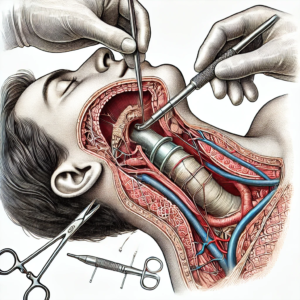Introduction
A tracheostomy is a surgical procedure that involves creating an opening in the neck to place a tube into a person’s windpipe (trachea). This tube allows air to enter the lungs, which is crucial for patients who have difficulty breathing due to various medical conditions. In Nepal, Dr. Prabhat Chandra Thakur is a leading expert in tracheostomy, renowned for his work in oral cancer, thyroid, head & neck cancer surgery, and endoscopic skull base surgery at the Nepal Cancer Hospital & Research Center, Harisiddhi, Lalitpur.
Tracheostomy Procedure
Dr. Prabhat Chandra Thakur explains that a tracheostomy procedure can be either an emergency or a planned procedure. Emergency tracheostomies are performed when there is sudden airway obstruction, while planned tracheostomies are scheduled for patients who require long-term ventilation support.
- Preparation: The patient’s neck is cleaned and sterilized. Local or general anesthesia is administered to minimize discomfort.
- Incision: A small incision is made in the lower part of the neck, just below the Adam’s apple.
- Creating the Opening: The surgeon carefully creates an opening in the trachea and inserts a tracheostomy tube.
- Securing the Tube: The tube is then secured in place with sutures and a neck strap.
Dr. Thakur emphasizes the importance of precision and care during the tracheostomy procedure to avoid damaging surrounding structures.
Tracheostomy Risks
As with any surgical procedure, tracheostomies carry certain risks and potential complications. Dr. Thakur highlights the following tracheostomy risks:
- Infection: The tracheostomy site can become infected if not properly cared for. Regular cleaning and monitoring are essential.
- Bleeding: Some bleeding is common immediately after the procedure, but excessive bleeding can occur.
- Air Leaks: Air may leak into the surrounding tissues, causing subcutaneous emphysema.
- Tube Displacement: The tracheostomy tube can become dislodged, leading to respiratory distress.
- Scar Tissue Formation: Over time, scar tissue can form around the tracheostomy site, potentially causing airway obstruction.
Dr. Thakur and his team take extensive measures to minimize these tracheostomy risks and ensure patient safety.
Tracheostomy Recovery
Post-operative care is crucial for a successful tracheostomy recovery. Dr. Thakur provides the following guidelines for tracheostomy recovery:
- Cleaning and Maintenance: The tracheostomy site and tube must be cleaned regularly to prevent infection. Caregivers are trained to handle this.
- Monitoring for Complications: Regular follow-ups with the healthcare provider are essential to monitor for any signs of complications during tracheostomy recovery.
- Speech and Swallowing Therapy: Patients may need therapy to adapt to changes in their ability to speak and swallow, aiding in tracheostomy recovery.
Tracheostomy Success Rates
The success rate of tracheostomy procedures performed by Dr. Prabhat Chandra Thakur is exceptionally high, thanks to his expertise and meticulous approach. His training, which includes a GOLD MEDAL AWARD for the best outgoing resident in PGI Chandigarh, India, and fellowships in head & neck oncology from IFHNOS & Memorial Sloan Kettering, New York, and minimal invasive thyroid surgery from General Hospital, Bangkok, has equipped him with the skills to handle complex cases. Dr. Thakur’s focus on patient safety and post-operative care significantly contributes to the high tracheostomy success rates.
Can a Person Still Talk After a Tracheostomy?
Yes, a person can often still talk after a tracheostomy, although it may require some adjustment and specific techniques. Dr. Thakur explains that the ability to speak depends on the type of tracheostomy tube and whether a speaking valve is used. A speaking valve allows air to pass over the vocal cords, enabling speech. Speech therapy can also help patients adapt to speaking with a tracheostomy.
Is a Tracheostomy Permanent or Temporary?
The duration of a tracheostomy depends on the underlying condition and the patient’s recovery. Dr. Thakur explains that many tracheostomies are temporary and can be reversed once the patient no longer needs it. However, some patients, particularly those with chronic or severe conditions, may require a permanent tracheostomy.
Can You Live a Normal Life After a Tracheostomy?
Many patients with a tracheostomy can lead normal, fulfilling lives. Dr. Thakur notes that with proper care and support, patients can return to their daily activities. It may take some time to adjust, but many people find they can speak, eat, and perform other normal functions with minimal limitations, leading to a successful tracheostomy recovery.
Dr. Prabhat Chandra Thakur’s extensive experience and dedication to patient care make him a leading expert in tracheostomy procedures in Nepal. His commitment to excellence ensures that patients receive the highest quality care, leading to successful outcomes and improved quality of life.
